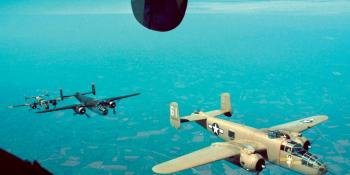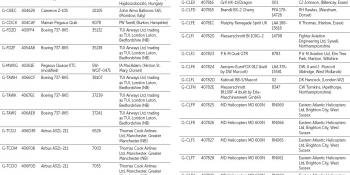Ludo Mennes and Frank Visser report from Leeuwarden Air Base on this year’s Dutch fighter weapons school course
From May 2017, the skies over northern Holland have been alive with the noise of fast jets because Koninklijke Luchtmacht F-16s were flying in a new Fighter Weapons Instructor Training (FWIT) course. Student pilots from the European Participating Air Forces (EPAF) F-16 community of Belgium, Denmark, Norway, the Netherlands and Portugal are learning to become weapons officers.
History
The first FWIT run by the Koninklijke Luchtmacht (KLU) took place at Leeuwarden Air Base in 1984. The new event was organized by 323 Squadron. Renamed in 1992 as the Tactical Training Evaluation and Standardization (TACTES) Squadron, the unit was tasked with providing advanced combat training for all Dutch pilots. The course is based on US Air Force weapons officer training, a gruelling course conducted by the Weapons School at Nellis Air Force Base, Nevada. The main difference between the two entities is that instructors serving with the US Air Force Weapons School provide the course curriculum as a fulltime job.
Nations participating in the FWIT send their experienced weapon officers, student pilots, technicians and most importantly aircraft from operational squadrons. After finishing the course instructors and students return to their own squadrons with the latest information on tactics and weapons ready to share their newly acquired knowledge with their fellow pilots.
Until 2014, 323 Squadron was responsible for organizing high quality FWIT courses and Frisian Flag; the annual multi-national exercise held at Leeuwarden. The squadron was deactivated at Leeuwarden and almost immediately reactivated at Edwards Air Force Base, California as the Operational & Tactical Evaluation Squadron for the Netherland’s newly acquired F-35A Lightning II. The TACTES tasks became the responsibility of 322 Squadron; the oldest operational KLU squadron. In 2016 the eighteenth edition of FWIT was planned and Major Nick was appointed as its new supervisor, responsible for organizing the six-month-long course. However, the KLU’s operational commitment with Air Task Force Middle-East (see Viper Strikes, November 2016, p84-89) placed such a heavy burden on the air force that the 2016 course was cancelled. Instead Major Nick and his team started planning for this year’s edition, which started in May.
FWIT squadron
Major Nick, an experienced fighter pilot, qualified mission commander and former FWIT graduate, presently commands more than 220 people, including 30 pilots flying 16 F-16s. The number of personnel under his command will increase to 250 when the course moves to Norway for its final phase. As supervisor, he is responsible for a core staff consisting of a director of operations, a deputy director, a technical coordinator, a mission planner and coordinators for intelligence and life support. Although the personnel from each nation start the course with their own aircraft, the over 130 ground crew are eventually pooled together to crossservice any one of the 16 jets. With a planned total of 300 missions the aircraft must be used as efficiently as possible. Instructors and student pilots all have special clearance to operate each other’s aircraft and weapon systems and will fly whichever aircraft is available. A record number of 16 student pilots is participating in this year’s FWIT, five Dutch, four Belgian, two Danish, three Norwegian and two Portuguese, plus an equal number of instructor pilots from all five nations.




FWIT selection
Seats are only reserved for the very best pilots and the FWIT selection process is difficult. Squadrons select candidates who must be endorsed by the ops-officer and squadron commander. The FWIT staff has no say in the matter. Standards among the different air forces are the same and professional judgment at squadron level is relied upon.
As Major Nick explained: “The selection process is a tough one. Beside the official qualifications of a preferred minimum of 1,000 flight hours (500 hours are the absolute minimum) and being qualified as a four-ship flight-lead, we are looking for guys that fit in the programme. This means they are above average pilots, have a positive attitude towards learning and have a talent for giving instructions. As the programme requires being away from home for almost seven months you really have to want this and you should be capable of handling extreme levels of stress.” Students are continually assessed during the course and can be expelled at any stage. At the time of writing, at the end of the air-toair phase, nobody had failed. A weapons officer’s task is a tough one because they serve as the squadron’s expert on tactics and weapon systems. Because of their knowledge they are jokingly referred to as ‘masters in F-16 science’. The maintenance of tactical standards, advising on tactical subjects related to specific operational areas to the pilots and the squadron commander and the upgrading of syllabuses for training flight-leads and mission qualifications all come within their remit. They are not only expert combat leaders, but also teachers for both new and experienced pilots within the squadrons.
Training structure
Once selected for the course, student pilots prepare at their home bases in the weeks prior to flying to Leeuwarden. Potential student pilots practice getting in the right mindset; focusing on the smallest details, doing all their briefings and debriefings in English and following all procedures according to FWIT protocols. This prepares the candidates in the best possible way and provides a level playing field for the pilots from the different participating air forces once they arrive at Leeuwarden.
The FWIT course consists of three flying phases: air-to-air, air-to-ground and mission employment (or mission integration). The air-to-air (or air combat) phase, which always takes place at Leeuwarden, ran from the beginning of May until July 14, when all crews returned home for a month-long summer break. This phase consisted of basic fighter manoeuvres followed by air combat manoeuvring, tactical intercepts and finally air combat training. Air combat events started with one-on-one fights and gradually built up to a scenario of four against four aircraft. As in previous courses, friendly air forces acted as Red air during the air combat phase - F-15E Strike Eagles from RAF Lakenheath and Luftwaffe EF-2000 Eurofighters from Laage and Wittmund Air Bases flew several missions. Red air newcomers to this year’s FWIT were four L-159E ALCAs operated by Draken International, which arrived from the United States on June 22 and returned to Nellis Air Force Base on July 12. As Major Nick stated: “Because of the amount of missions flown the demand for the necessary Red air is large as we are trained to fly Blue air missions, which is a totally different game. By using Blue air capacity as Red air, we put too much pressure on the limited number of aircraft and crews at the different squadrons.”

Air-to-ground operations started on August 14 with students flying basic range missions, followed by basic surface attack and opposed surface attack.
In October, mission integration, the final phase will take place at Main Air Station Bodø in Norway where pilots will combine all of the techniques and tactics taught throughout the course. The integration phase focuses on coordination with other air and ground assets in a complex environment. Norway was chosen because there are fewer noise abatement problems than over the densely populated Netherlands and for the availability of low-flying areas.
At the graduation ceremony planned for November 9, graduates will remove the FWIT patch from their left arm and put the much-desired blue weapons instructor patch on the right.
TWIC
Another first for this year’s FWIT is the participation of Dutch C-130 Hercules pilots from 336 Squadron, based at Eindhoven. Four pilots are enrolled in the first Transport Weapons Instructor Course (TWIC) with the aim of being the first weapon instructors in the KLU C-130 community. Pilots will learn how to complete missions safely using fire support from fighter aircraft. Integration of the heavies into the main FWIT course shares the knowledge of both communities and gives participants an insight into the problems and requirements of their air transport colleagues. Major Darryl, both supervisor and student at the same time, seemed to be pleased with the new joint weapons instructor course. His adage is “We either do it or don’t.” The four C-130 pilots in this TWIC include one American and one Belgian exchange pilot. Just like the FWIT participants only the best pilots were selected to follow the course. Cooperation with their US counterparts is of the highest importance to the Dutch C-130 community. The idea of integrating airlift in this year’s FWIT was the brainchild of the two supervisors. Major Darryl explained: “Evaluating the airlift mission we concluded that 80-90% of the tactics are more or less the same for both platforms, which was an eye opener for all of us. The regular European airlift programme does not offer the necessary tactical training and therefore we decided to start a joint course with the F-16 community.” Two missions were flown against F-16s during the air-to-air phase where the Hercules was attacked and had to defend itself. To maximize the lessons learned, an F-16 pilot flew on the C-130 and a C-130 pilot flew in an F-16B. Both sides agreed, and the transport crew was pleased to learn, that downing a Hercules with its protective countermeasures and manoeuvrability is difficult. TWIC coincides with FWIT for a short while when students for both courses come together at Leeuwarden, but for the rest of the programme TWIC pilots fly from their home base.
All phases during FWIT and TWIC start in the classroom. The air-to-air phase started with a five-week academic course at Leeuwarden with the C-130 pilots joining for the first two weeks for so-called core academics. Amongst the topics taught were the infrared waveform, airborne radar and the use of counter measures. C-130 pilots flew five missions with F-16s during the first phase. After the summer break the air-to-ground phase again started with a two-week academic course; C-130 pilots attended the first week. For the final mission employment phase in October the TWIC will join for one week to fly lowlevel night vision goggle sorties. During the integration stage one of the participating C-130 pilots will also act as mission commander, bringing the FWIT and TWIC together at peak integration. Both Majors Darryl and Major Nick are quite clear about the results so far: “Even though there is still much to learn, we see that combining the programmes and missions works very well. Planning, executing and debriefing provides us with an enormously steep learning curve.” Although it’s still early both supervisors hope the FWIT and TWIC courses will be combined in the future.
Future
The last FWIT course with the F-16MLU as platform of choice is planned for 2019 - the first F-35A Lightning IIs are planned to enter service the same year. At the moment, the KLU has decided not to integrate fourth and fifth-generation fighter aircraft in a combined course and will instead focus on the implementation of the new jet. Hopefully FWIT will continue and the first plans are being made to start a joint weapons course in 2021, together with the Norwegians who are also working to implement the F-35. As major Nick said: “This course is world class in its quality and deserves continuation in the future. The blue FWIT patch on the sleeve not only represents its short-term value in the squadron today, but also on the long term as today’s fighter pilots become the decision makers of tomorrow. They have acquired the right knowledge and experience to make the wisest decisions in the best interests of the entire air force.”




